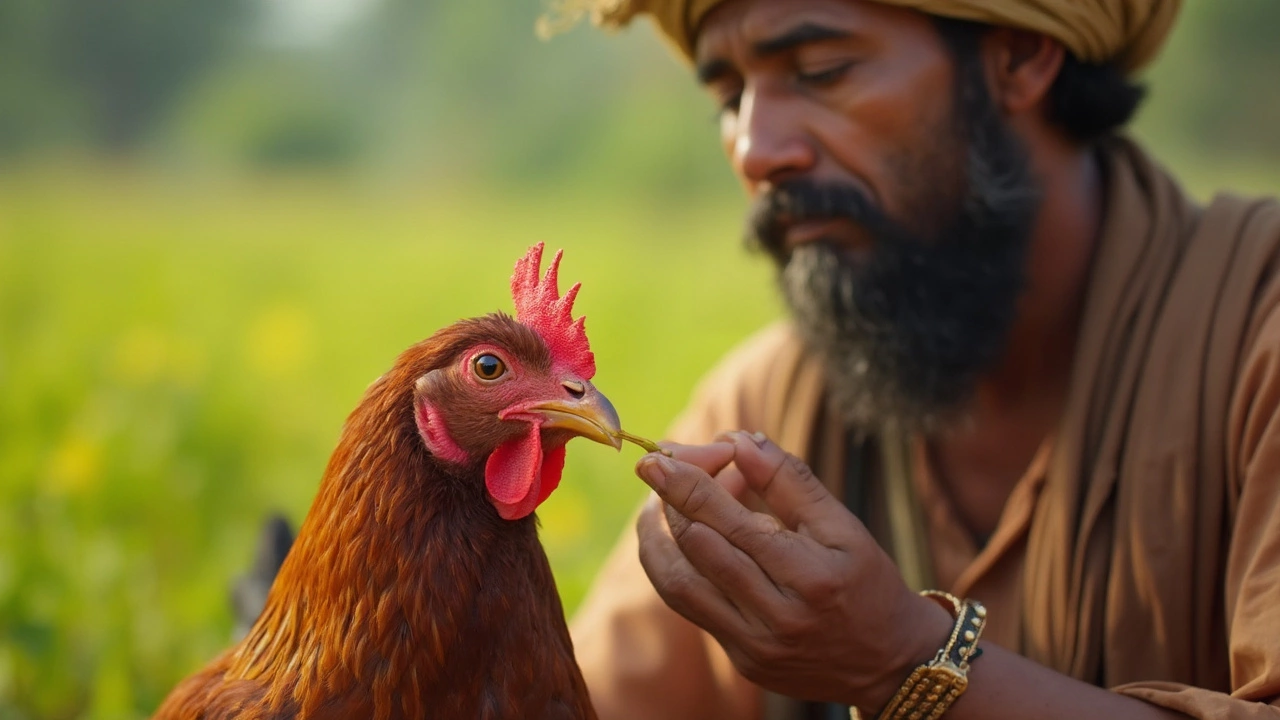Yellow Stuff in Chicken Mouth – Causes, Meaning & Fixes
When you spot yellow stuff in chicken mouth, a yellowish coating or residue that shows up on the beak or inside the oral cavity of a chicken. Also known as yellow discoloration, it often hints at something about the bird’s diet, health, or handling. The same sign can appear in backyard flocks, commercial farms, or even in market‑bought poultry. Understanding it helps you keep chickens healthy and prevents odd color from ending up on your dinner plate.
One of the most common culprits is turmeric, a bright yellow spice used in many Indian recipes. If the feed contains turmeric powder or if the bird has been fed a curry‑spiced mash, the pigment can seep into the mouth and appear as a golden film. Chicken, a domesticated bird raised for meat and eggs naturally absorbs dietary pigments, so a sudden change in feed color often shows up first in the mouth. This is a harmless cosmetic effect, but it can alarm owners who aren’t expecting it.
Other Reasons Behind the Yellow Discoloration
Besides turmeric, several other factors can cause the yellow stain. High‑corn diets push a natural carotenoid called xanthophyll into the bloodstream, which can deposit in the beak and mouth. Vitamin A deficiency sometimes produces a dry, yellowish crust as the skin struggles to stay moist. Bacterial infections such as Pasteurella can create pus that looks yellow, especially if the bird’s immune system is stressed. Lastly, improper slaughter handling can leave residual blood mixed with bile, which hardens into a yellow film on the mouth cavity.
If the yellow part looks more like a slime than a solid coat, it may be yellow discharge from a respiratory issue. Chickens that cough or sneeze often release mucus that turns yellow when fighting off infection. In such cases, the color isn’t from food at all but a sign that a vet check is needed. While the symptom itself isn’t dangerous, ignoring an underlying infection can spread to the whole flock.
Cleaning habits also matter. A dirty perch or feeder can harbor feed residues that turn yellow once they dry. Regularly wiping beaks with a damp cloth or providing clean water reduces the buildup. Some owners dip the beak in a mild lemon, a sour citrus fruit rich in acid solution. The acid breaks down the pigment and any slime, leaving the mouth fresh and white. Lemon also discourages bacterial growth, making it a simple home remedy.
Spices beyond turmeric can leave a hue. Saffron, annatto, and even mustard seeds add yellow pigments that travel through the digestive tract. If you’re experimenting with Indian curries that use a heavy blend of curry spices, a mix of herbs and powders that give dishes their flavor, expect the chicken’s mouth to reflect that brightness. The effect fades once the bird stops eating the spiced feed.
What should you do when you see the yellow stuff? First, identify any recent feed changes. If you added a new grain or spice, revert to the old mix and watch for improvement within a week. Second, check the bird’s overall health: breathing patterns, feather condition, and appetite. If any of those seem off, consult a veterinarian. Third, incorporate a daily clean‑water routine and consider a light dip in diluted lemon juice to strip the pigment.
Sometimes the yellow layer is simply a sign of good nutrition. Carotenoid‑rich feed can make egg yolks richer and meat more flavorful. In backyard settings, many owners actually seek that golden hue as a marker of a well‑fed flock. If you’re comfortable with the look and the birds are healthy, there’s no urgent need to intervene.
To sum up, the yellow stuff in a chicken’s mouth usually ties back to diet (turmeric, corn, saffron), health (vitamin deficits, infections), or hygiene (feed residue). Lemon juice, proper cleaning, and a balanced feed are the go‑to fixes. Keeping an eye on the bird’s behavior will tell you whether the discoloration is harmless or a warning sign.
Below you’ll find a collection of articles that dive deeper into related topics—everything from the science of why lemon curdles milk, to the secrets behind creamy curries, and tips for perfect rotis. Whether you’re fixing a color issue or just curious about Indian spices, the posts ahead give practical advice you can try right away.

Yellow Bumps in Chicken’s Mouth: Causes, Treatment, and Prevention
Yellow stuff in your chicken's mouth can signal health issues like canker, fowl pox, or vitamin deficiencies. Learn to spot causes, treat, and prevent problems.